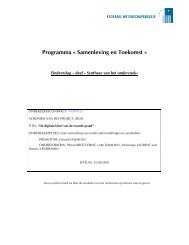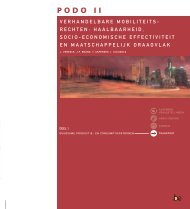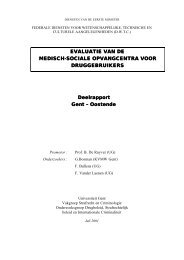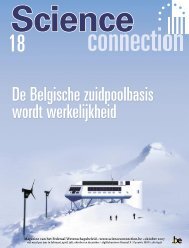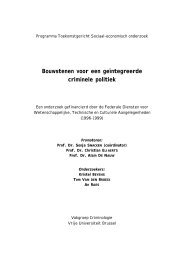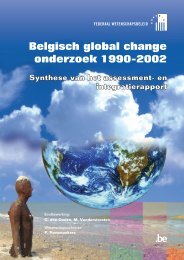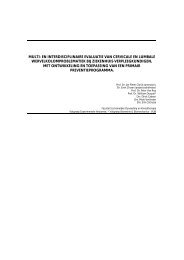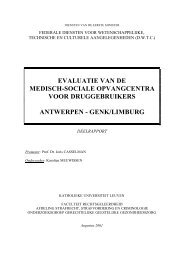chapter 3 inventory of local food systems
chapter 3 inventory of local food systems
chapter 3 inventory of local food systems
Create successful ePaper yourself
Turn your PDF publications into a flip-book with our unique Google optimized e-Paper software.
Project CP/59 - “Instruments and institutions to develop <strong>local</strong> <strong>food</strong> <strong>systems</strong>”<br />
The EFP succeeds in reducing these three processes to one primary cause, which is the<br />
human consumption <strong>of</strong> biologically productive land. For instance, the increase <strong>of</strong> CO2<br />
in the atmosphere by burning fossil fuels is converted into the ‘area <strong>of</strong> wood to be<br />
planted’ needed to absorb this CO2 (Borgström Hansson and Wackernagel, 1999). The<br />
unit <strong>of</strong> the EFP is the amount <strong>of</strong> productive land (and water) that must provide enough<br />
energy and material sources for consumption and be able to absorb the waste produced.<br />
This EFP can be measured at an individual level, but also for a city, a region, a land or<br />
the entire planet (Wackernagel and Rees, 1996; Anderson and Lindroth, 2001;<br />
www.gdrc.org/uem/footprints/what-is-ef.html).<br />
This method allows to make a comparison between the EFP and the available capacity.<br />
If the EFP <strong>of</strong> a population is higher than the biophysical capacity <strong>of</strong> its territory, then<br />
extra capacity should be imported from other territories, or the own ecological capacity<br />
will be eroded and the pressure on the remaining bio-productive space will increase<br />
(Anderson & Lindroth, 2001; Wackernagel et al. 1999; Borgström Hansson and<br />
Wackernagel, 1999).<br />
Some also use the term ‘ecological debt’ in this context. Its definition is usually<br />
presented as ‘the cumulative responsibility the industrialized countries have, because <strong>of</strong><br />
human exploitation, robbery <strong>of</strong> raw materials and minerals, pollution and cultural<br />
dominance towards the developing countries’. This ecological debt can be calculated by<br />
the average ‘EFP per capita’ <strong>of</strong> a specific region, to be compared with the ‘capacity <strong>of</strong><br />
the land per capita’. If this EFP is larger than the capacity, one says there is ecological<br />
debt because we have to compensate over-consumption by import from the South and<br />
because many countries in the south have an EFP per capita that is below the capacity<br />
per capita.<br />
(www.vodo.be/documenten/Peccei%20lectures.htm,<br />
www.vodo.be/html/themas/index.htm)<br />
Even though the EFP is a useful instrument to make a rough estimate <strong>of</strong> the ecological<br />
impact <strong>of</strong> the life style <strong>of</strong> a certain population, the EFP has also certain limitations. A<br />
number <strong>of</strong> impacts are left aside, such as the emission <strong>of</strong> highly toxic waste and the use<br />
<strong>of</strong> non-renewable raw materials, ins<strong>of</strong>ar as they do not put a claim on the land for their<br />
production or distribution and processing. That implies that the EFP underestimates the<br />
ecological impact. However, it does describe the actual use <strong>of</strong> the biophysical<br />
production capacity <strong>of</strong> the Earth, as well as the measure to which the human beings are<br />
“over-consuming” nature (Anderson and Lindroth, 2001).<br />
1.4. Conclusions<br />
Based on our literature review we define <strong>local</strong> <strong>food</strong> <strong>systems</strong> as follows: “Local <strong>food</strong><br />
<strong>systems</strong> encompass the entire chain <strong>of</strong> producing, processing, selling and consuming<br />
<strong>food</strong> They are collective <strong>systems</strong> in which there is direct contact between producer and<br />
consumer and/or in which they engage is a long-term contractual relationship. The<br />
distance between the different actors should be minimal (both geographically and with<br />
respect to the number <strong>of</strong> intermediates in the chain).”<br />
SPSD II - Part I - Sustainable production and consumption patterns - Agro-Food 23



